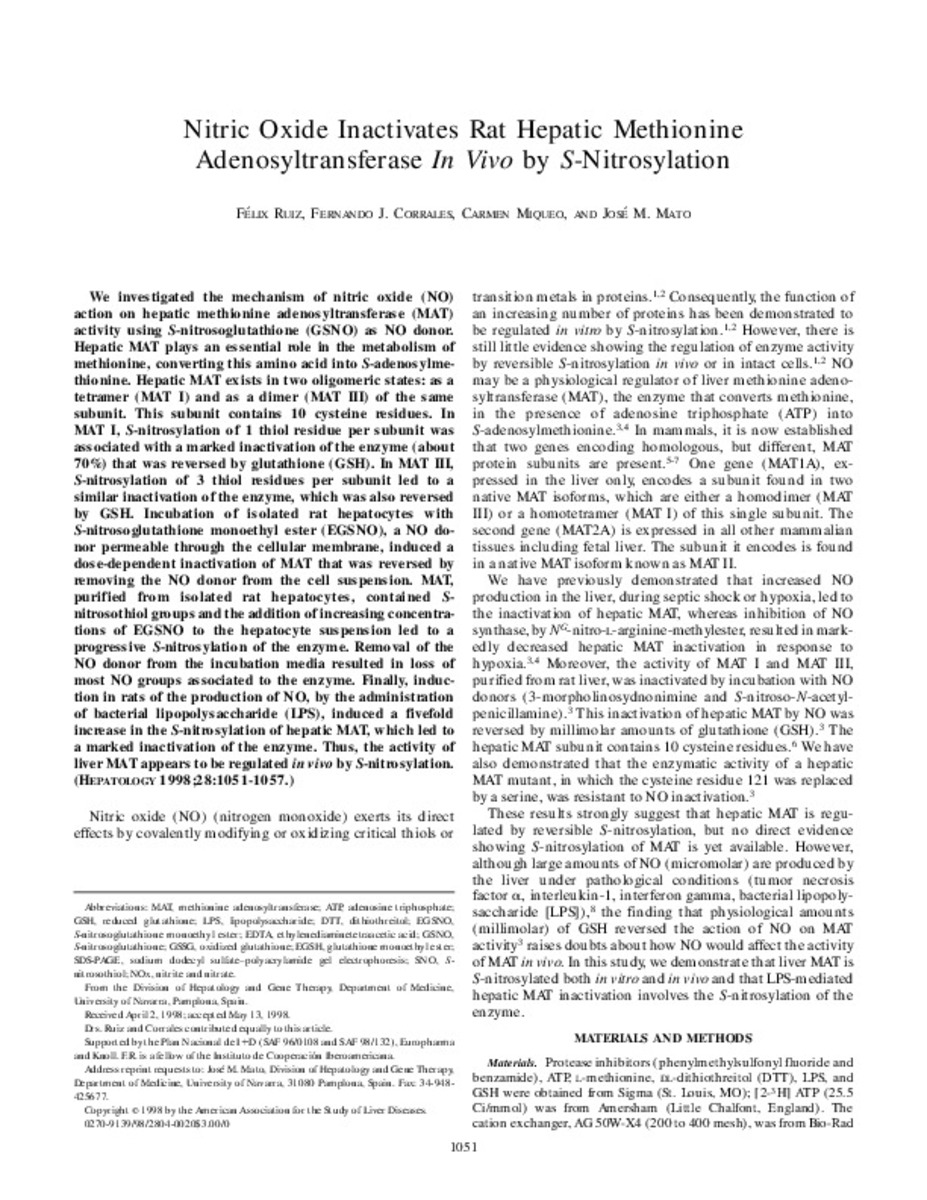Full metadata record
| DC Field | Value | Language |
|---|---|---|
| dc.creator | Ruiz, F.A. (Félix A.) | - |
| dc.creator | Corrales, F.J. (Fernando José) | - |
| dc.creator | Miqueo, C. (C.) | - |
| dc.creator | Mato, J.M. (José María) | - |
| dc.date.accessioned | 2012-04-03T11:27:33Z | - |
| dc.date.available | 2012-04-03T11:27:33Z | - |
| dc.date.issued | 1998 | - |
| dc.identifier.citation | Ruiz F, Corrales FJ, Miqueo C, Mato JM. Nitric oxide inactivates rat hepatic methionine adenosyltransferase In vivo by S-nitrosylation. Hepatology 1998 Oct;28(4):1051-1057. | es_ES |
| dc.identifier.issn | 1527-3350 | - |
| dc.identifier.uri | https://hdl.handle.net/10171/21550 | - |
| dc.description.abstract | We investigated the mechanism of nitric oxide (NO) action on hepatic methionine adenosyltransferase (MAT) activity using S-nitrosoglutathione (GSNO) as NO donor. Hepatic MAT plays an essential role in the metabolism of methionine, converting this amino acid into S-adenosylmethionine. Hepatic MAT exists in two oligomeric states: as a tetramer (MAT I) and as a dimer (MAT III) of the same subunit. This subunit contains 10 cysteine residues. In MAT I, S-nitrosylation of 1 thiol residue per subunit was associated with a marked inactivation of the enzyme (about 70%) that was reversed by glutathione (GSH). In MAT III, S-nitrosylation of 3 thiol residues per subunit led to a similar inactivation of the enzyme, which was also reversed by GSH. Incubation of isolated rat hepatocytes with S-nitrosoglutathione monoethyl ester (EGSNO), a NO donor permeable through the cellular membrane, induced a dose-dependent inactivation of MAT that was reversed by removing the NO donor from the cell suspension. MAT, purified from isolated rat hepatocytes, contained S-nitrosothiol groups and the addition of increasing concentrations of EGSNO to the hepatocyte suspension led to a progressive S-nitrosylation of the enzyme. Removal of the NO donor from the incubation media resulted in loss of most NO groups associated to the enzyme. Finally, induction in rats of the production of NO, by the administration of bacterial lipopolysaccharide (LPS), induced a fivefold increase in the S-nitrosylation of hepatic MAT, which led to a marked inactivation of the enzyme. Thus, the activity of liver MAT appears to be regulated in vivo by S-nitrosylation. | es_ES |
| dc.language.iso | eng | es_ES |
| dc.publisher | Wiley-Blackwell | es_ES |
| dc.rights | info:eu-repo/semantics/openAccess | es_ES |
| dc.subject | Glutathione/analogs & derivatives | es_ES |
| dc.subject | Liver/metabolism | es_ES |
| dc.subject | Liver/metabolism | es_ES |
| dc.subject | Methionine Adenosyltransferase/antagonists & inhibitors | es_ES |
| dc.subject | Nitric Oxide Donors/pharmacology | es_ES |
| dc.subject | Nitroso Compounds/pharmacology | es_ES |
| dc.title | Nitric oxide inactivates rat hepatic methionine adenosyltransferase In vivo by S-nitrosylation | es_ES |
| dc.type | info:eu-repo/semantics/article | es_ES |
| dc.relation.publisherversion | http://onlinelibrary.wiley.com/doi/10.1002/hep.510280420/abstract | es_ES |
| dc.type.driver | info:eu-repo/semantics/article | es_ES |
Files in This Item:
Statistics and impact
Items in Dadun are protected by copyright, with all rights reserved, unless otherwise indicated.






